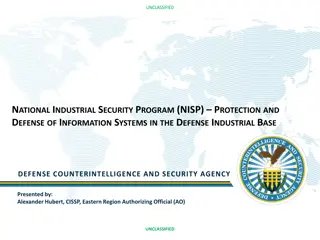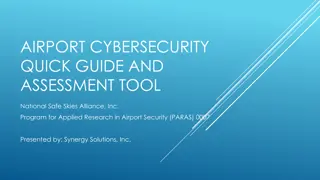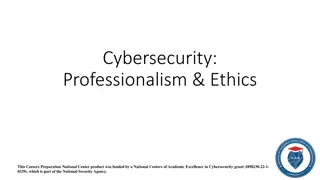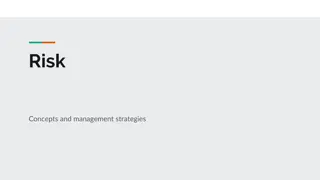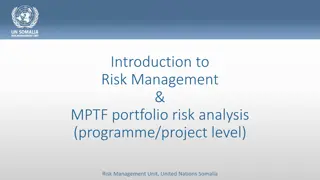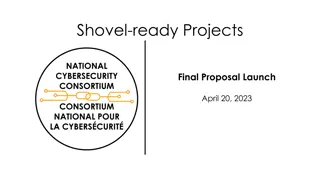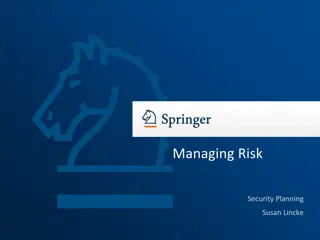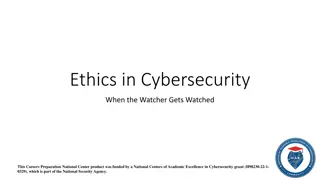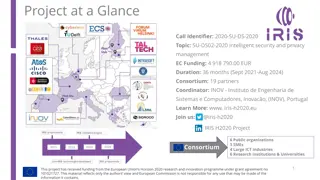
Is Your Cybersecurity Putting Your Business at Risk?
Discover if your business's cybersecurity measures are sufficient. Learn how to protect your data and secure your digital assets effectively.n
Download Presentation

Please find below an Image/Link to download the presentation.
The content on the website is provided AS IS for your information and personal use only. It may not be sold, licensed, or shared on other websites without obtaining consent from the author. If you encounter any issues during the download, it is possible that the publisher has removed the file from their server.
You are allowed to download the files provided on this website for personal or commercial use, subject to the condition that they are used lawfully. All files are the property of their respective owners.
The content on the website is provided AS IS for your information and personal use only. It may not be sold, licensed, or shared on other websites without obtaining consent from the author.
E N D
Presentation Transcript
Is Your Cybersecurity Putting Your Business at Risk? Any organization that wants to grow and expand must recognize digital transformation or DX. However, the growing technological footprint also significantly raises the likelihood of a cyberattack. The requirement for specialized cybersecurity services Toronto or IT specialists who can handle the challenges of maintaining an organization's security becomes apparent when you take the increased risk into account. With the increasing number of cyber threats and sophisticated attacks, ensuring the security of your business s data and systems is not just an IT issue but a critical business imperative. A Sneak Peek of Cybersecurity Landscape Cyber attacks have become more frequent and complex over the years. Hackers employ a variety of methods, from phishing and ransomware to advanced persistent threats (APTs) and zero-day exploits, to breach security defenses.
The global cost of cyberattacks was $8 trillion in 2023 with expectations of rising to 9.5 trillion in 2024 and $10.5 trillion in 2025. Common Cybersecurity Threats Phishing Attacks: These involve tricking employees into revealing sensitive information by masquerading as trustworthy entities in emails or messages. Ransomware: Malicious software that encrypts data and demands payment for its release. Malware: Software designed to disrupt, damage, or gain unauthorized access to systems. Insider Threats: Employees or former employees who exploit their access to data for malicious purposes. DDoS Attacks: Distributed Denial of Service attacks overwhelm a system with traffic, causing it to become unavailable. Read More Articles: Balancing Proactive and Reactive Cyber Defenses The Risks of Inadequate Cybersecurity 1. Financial Losses The financial ramifications of a cyber attack can be devastating. Beyond the immediate costs of remediation and recovery, businesses may face fines for non-compliance with data protection regulations, legal fees, and loss of revenue due to downtime. Additionally, there can be long-term financial consequences as customers and partners lose trust in a compromised business. 2. Reputation Damage According to the leading Canadian Cyber Security company, a security breach can significantly tarnish a company s reputation. Customers entrust businesses with their personal and financial information, and a breach can erode that trust. The negative publicity surrounding a data breach can lead to a loss of customers, a decline in stock value, and a damaged brand image that can take years to rebuild.
3. Legal and Regulatory Consequences Many industries are subject to stringent data protection regulations, such as: The General Data Protection Regulation (GDPR) in Europe The Health Insurance Portability and Accountability Act (HIPAA) in the United States Failure to comply with these regulations due to a cybersecurity breach can result in hefty fines and legal action, further compounding the financial impact. 4. Operational Disruptions Cyber attacks can disrupt business operations, which culminates in significant downtime. Whether it s a ransomware attack that locks critical systems or a DDoS attack that overwhelms online services, the impact on day-to-day operations can be severe. This disruption can result in: Lost productivity Missed business opportunities Frustrated customers Assess Your Cybersecurity Posture 1. Conduct a Risk Assessment A thorough risk assessment performed by a cybersecurity services provider is the first step in understanding your cybersecurity posture. This involves: Identifying the assets that need protection, such as customer data, intellectual property, and financial information Evaluating the potential threats to these assets A risk assessment helps in prioritizing the implementation of security measures based on the level of risk each asset faces.
2. Evaluate Existing Security Measures Once you have identified the risks, the next step is to evaluate the effectiveness of your existing security measures. This includes reviewing: Firewalls Antivirus software Intrusion detection systems Encryption protocols A network security audit Toronto and penetration testing can help detect vulnerabilities that need to be addressed. 3. Focus on Employee Training and Awareness Human error is a significant factor in many cybersecurity breaches. Ensuring that employees are trained to recognize and respond to cyber threats is crucial. Regular training sessions and awareness programs can help employees stay vigilant and understand the importance of following security protocols. Tips to Enhance Your Cybersecurity Implement Advanced Security Technologies Investing in advanced security technologies can provide a robust defense against cyber threats. These technologies include: Next-Generation Firewalls: These offer more advanced features than traditional firewalls, such as deep packet inspection and intrusion prevention. Endpoint Protection: Comprehensive solutions that protect all endpoints, including desktops, laptops, and mobile devices. Encryption: Ensuring that data is encrypted both in transit and at rest to prevent unauthorized access. Multi-Factor Authentication (MFA): Adding an extra layer of security by requiring multiple forms of verification before granting access.
Regularly Update and Patch Systems Keeping software and systems up to date is critical in defending against cyber threats. Regular updates and patches address known vulnerabilities that hackers could exploit. Implementing a patch management process ensures that all systems are consistently updated with the latest security patches. Read More Articles: Best Practices for Small Businesses to Avoid Cyber Incidents Develop an Incident Response Plan Despite the best preventive measures, it s essential to be prepared for a potential breach. Developing an incident response plan outlines the steps to take in the event of a cyber attack. This plan should include: Detection and Identification: How to detect and identify a breach quickly. Containment: Steps to contain the breach and prevent further damage. Eradication: Removing the threat from the system. Recovery: Restoring systems and data to normal operations. Communication: Informing stakeholders, customers, and regulatory bodies as required. Partner with a Cybersecurity Expert For many businesses, managing cybersecurity in-house can be challenging due to limited resources and expertise. Partnering with cybersecurity experts or managed security service providers (MSSPs) can provide access to: Specialized knowledge Advanced security tools These experts can offer continuous monitoring, threat detection, and incident response, thereby helping businesses stay ahead of evolving cyber threats.
The Bottom Line In an era where cyber threats are constantly evolving, businesses must prioritize cybersecurity to protect their assets, reputation, and operations. Inadequate cybersecurity measures can expose businesses to significant financial losses, reputational damage, legal consequences, and operational disruptions. The evolving landscape of cybersecurity presents both challenges and opportunities and staying ahead of these trends is essential for maintaining a secure and resilient business environment. As the top Canadian Cyber Security company, IT-Solutions.CA offers a range of cybersecurity services tailored to your specific goals, so you may rely on our professionals and let us improve your overall cybersecurity strategy! Site Article: Is Your Cybersecurity Putting Your Business at Risk?





